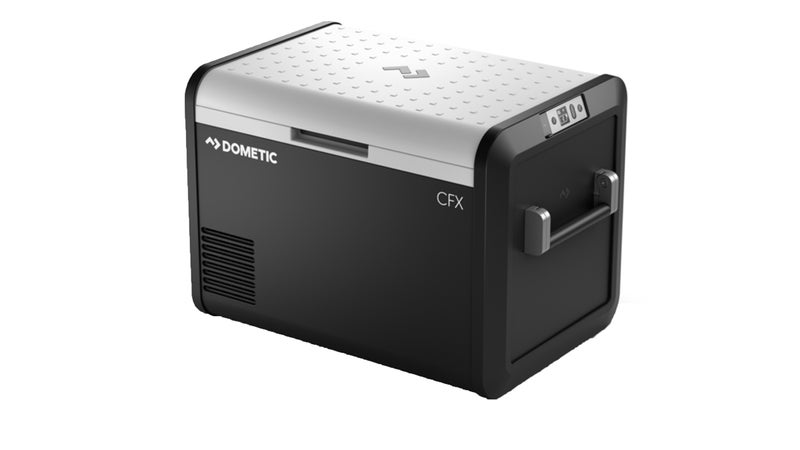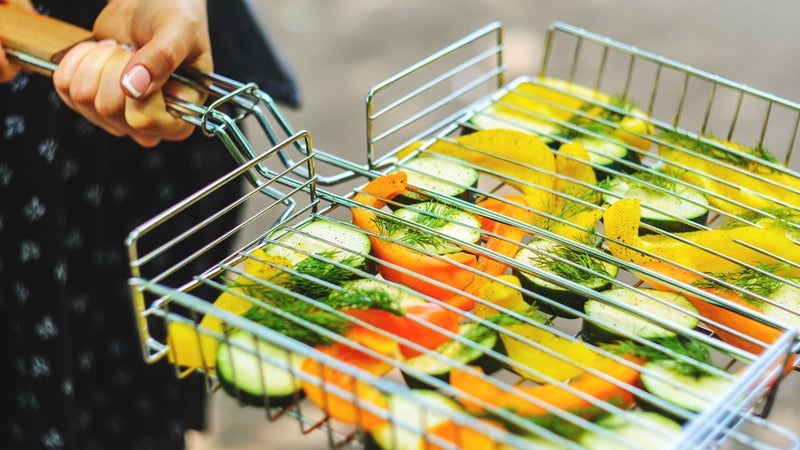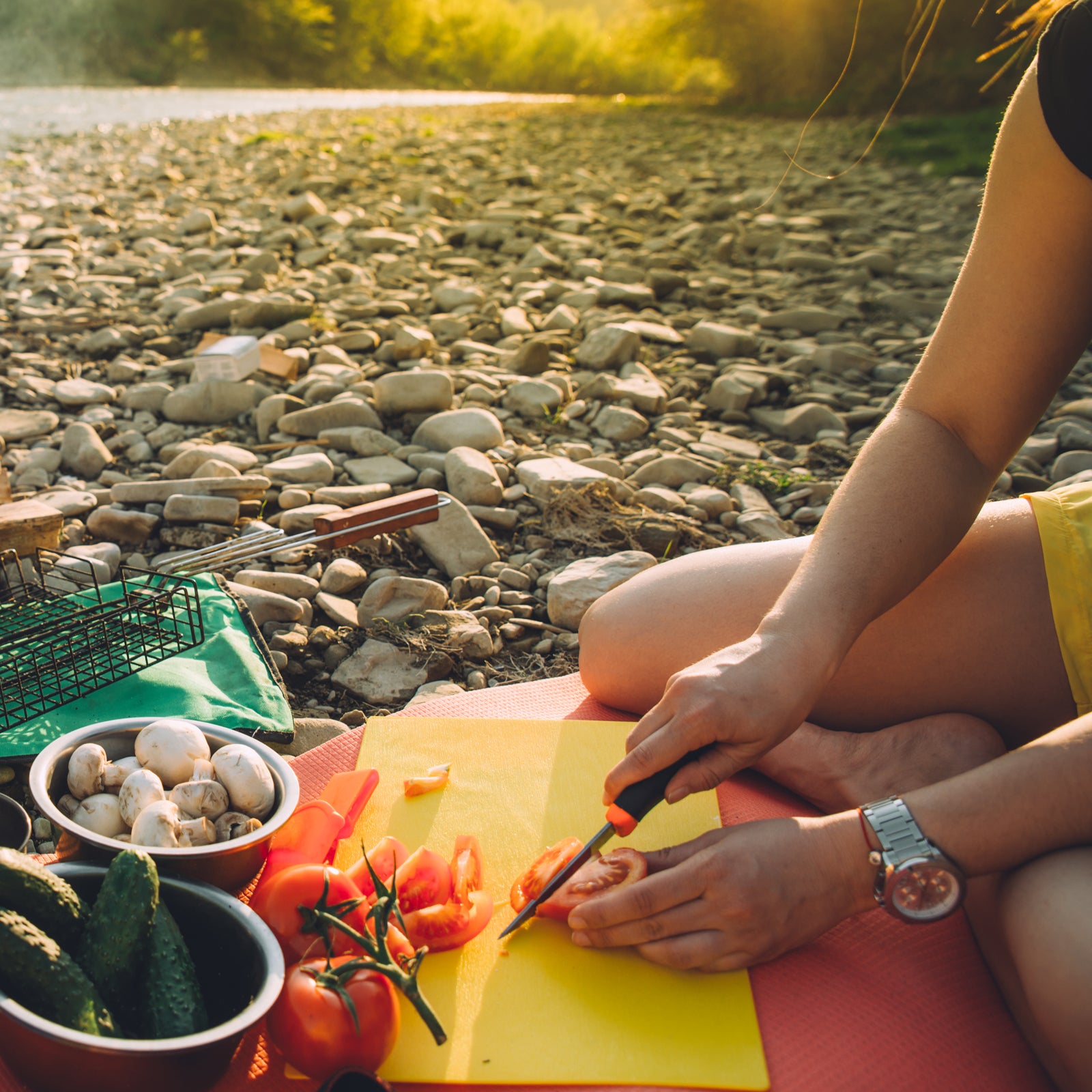Like the rest of the country, IÔÇÖve swapped out more far-flung summer vacations for╠řclose-to-home road trips.╠řMy wife and I have camped quite a bit this summer, including a recent weeklong trip where we took some extra precautions to be as self-sufficient on the move╠řas possible. Aside from stopping for gas, we didnÔÇÖt have contact with anyone. The key to making that happen was╠řpacking all our food. HereÔÇÖs how we did itÔÇöand how you can, too.╠ř
Get the Right Gear

First and foremost, nothing prepares you to be╠řself-sufficient food-wise on the road╠řlike a portable fridge. I think the phrase ÔÇťgame changerÔÇŁ is overused in gear reviews, but thatÔÇÖs exactly what a fridge is for road trips and camping. Not having to fill a cooler with ice means you wonÔÇÖt end up with soggy food or with a box full of nasty swamp water when the juice from those burger patties leaks out.╠ř
It also means you wonÔÇÖt need to restock on ice, no matter how long you stay out. IÔÇÖve used a ╠ř(from $960) for a few years and highly recommend it. Since you donÔÇÖt need ice,╠řthereÔÇÖs more space than a similar-size╠řcooler. If you pack well and frugally, the 50 liters can fit two to three meals a day for two people for up to a week (it did for us, at least).╠řDometic also makes units with , which means you can effectively stay on the road without going to the grocery store for even longer.
YouÔÇÖll need something to power the fridge, and while you can plug it into your vehicleÔÇÖs 12-volt╠řoutlet,╠řa battery will be necessary to run it when youÔÇÖre not driving. I use DometicÔÇÖs PLB40 battery╠ř(from $850), which is great because it powers the fridge for on a single charge. The best part╠řis that you can recharge it from your carÔÇÖs 12-volt╠řplug as you drive, and itÔÇÖll power the fridge at the same timeÔÇöso youÔÇÖd be hard-pressed to run out of juice during a road trip where youÔÇÖre driving every day.╠ř
We also bring a small, soft-sided cooler, like the 30-liter╠ř╠ř(from $300), for all of the snacks and cans of╠řLaCroix╠řwe want within reach while driving.╠řThen you donÔÇÖt have to open the fridge as much, which in our case╠řwould mean stopping to access it from our teardrop trailer.╠ř
If youÔÇÖre looking for a more affordable option than a portable fridge, go with a 45-to-50-liter╠řcooler from a brand like ╠řor Yeti. ╠řline of coolers (from $250) has worked better for me and kept things cooler longer than any other cooler IÔÇÖve used over the years. If you pack it correctly with a ton of ice, it will keep your food cold for a day or two at a time. That said, for a longer trip, itÔÇÖs just not as good of a solution as a portable fridge for being totally self-sufficient.╠ř
Pack Efficiently
With a portable fridge,╠řyou donÔÇÖt need to worry about about whether your food is sealed watertight or thereÔÇÖs╠řroom for ice.╠řIf you go with a cooler, watch this video,╠řand make sure to utilize the little basket that often comes with coolers for╠řitems like eggs and cheeses╠řthat you donÔÇÖt want╠řjostled or crushed.╠ř
My wife╠řand I like to prepare and pack all of our food by meal. For example, weÔÇÖll cut up veggies and put them in a Ziploc╠řwith a package of chicken and the accompanying sauce, and then weÔÇÖll label the meal with the day we plan╠řto cook it. This helps with food-safety issues, because we can keep╠řtrack of╠řthe mealÔÇÖs expiration date.
Another trick is to pack your ingredients in a container (either using╠řTupperware╠řor╠řreusable Ziplocs) that you can then eat out of or store leftovers╠řin. Doing so helps reduce the amount of packages and containers youÔÇÖll need to bring.╠ř
Bring the Right Kind of Food╠ř

It doesnÔÇÖt matter how well you pack if you donÔÇÖt bring food that is conducive to a road trip. YouÔÇÖll want to shop for╠řthings that are relatively easy to cook, will last for the duration of your trip, and arenÔÇÖt going to require many extra ingredients. One of our go-to meals is stir-fry with a precooked steamed rice pouch. HereÔÇÖs what we put in it: dried, frozen, fresh, or canned vegetables (depending on how long weÔÇÖll╠řbe on the road),╠řa stir-fry sauce,╠řand a protein, like chicken or eggs. To keep things easy, we╠řoften opt for canned chicken or those foil pouches you can find at some grocery stores.╠ř
Pastas always store well, and╠řpremade burger patties, tacos, and fajitas are great options because theyÔÇÖre easy to cook. We often slow-cook chicken breasts in salsa in advance of our trip so we have taco meat ready to reheat once weÔÇÖre on the road. Preparing certain ingredients ahead of time╠řmakes it easierÔÇöand often saferÔÇöthan trying to cook a lot of raw meats without a full kitchen. My wife also likes to prepare side dishes╠řlike roasted potatoes, which are easy to heat up.
IÔÇÖve found that peopleÔÇÖs biggest complaint about road-trip and camping food is a lack of fresh fruit and vegetables, so itÔÇÖs important to think about incorporating more of each into your meals. A fridge makes that easier to do, as do bagged saladsÔÇöthe easier you can make it on yourself, the more veggies youÔÇÖll eat. Having a regular supply of fruits and vegetables╠řalso helps avoid that gross feeling you get after three days of eating garbage, which is always a tempting excuse╠řto go to the store and pick up some ÔÇťreal food.ÔÇŁ╠ř
The most important part of being self-sufficient on the road is bringing enough snacks. We all love running into the gas station for a candy bar and drink, but having those items╠řon hand in a separate, small cooler means you wonÔÇÖt feel the need to. We like chips and salsa, hummus, cheese, salami, mini bell peppers, apples, and something sweet. We also bring a bag of clementines with us, since theyÔÇÖre easy to peel and eat anywhere.
Embrace Delivery Options
Remember that youÔÇÖre trying to be self-sufficient on a road trip, not just to protect yourself╠řbut to make sure you donÔÇÖt infect anyone else or bring the virus into a small town that doesnÔÇÖt have the medical facilities to handle an outbreak.
To minimize your contact, consider the stops youÔÇÖre╠řgoing to make ahead of time, and research what stores offer╠řcurbside grocery pickup so you donÔÇÖt have to go inside.╠řMany grocery chains, including╠řSamÔÇÖs Club, Target, and Walmart, have╠řthis option, and some local stores have started offering this service as well.╠ř
Takeout from a restaurant is an option if you run out of your own food. Just remember that delivery services like Fetch, Instacart, and Uber Eats arenÔÇÖt going to be able to provide you with as many choices in small mountain towns.
Outdoorsy Bonus Points: Catch or Forage Your Own Food
If your road trip will take you near any lakes or rivers, you can try catching fish for dinner. My wife and I love to fish, so we always have spices ready to fix a meal if we land╠řsomething, as well as cooking essentials╠řlike olive oil, salt, pepper, and foil╠řto╠řwrap and cook the fish╠řover coals.


